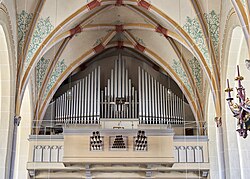Triftern, St. Stephan: Unterschied zwischen den Versionen
| Zeile 1: | Zeile 1: | ||
{{Orgelbeschreibung | {{Orgelbeschreibung | ||
|BILD 1= Triftern, St. Stephan.jpg |BILD 1-Text= Wölfl-Meier-Orgel in Triftern | |BILD 1= Triftern, St. Stephan.jpg |BILD 1-Text= Wölfl-Meier-Orgel in Triftern | ||
| − | |BILD 2= Katholische Pfarrkirche St. Stephan Triftern 05.0.jpg |BILD 2-Text= | + | |BILD 2= Katholische Pfarrkirche St. Stephan Triftern 05.0.jpg |BILD 2-Text= |
| − | |BILD 3= Katholische Pfarrkirche St. Stephan Triftern 09.0.jpg |BILD 3-Text= | + | |BILD 3= Katholische Pfarrkirche St. Stephan Triftern 09.0.jpg |BILD 3-Text=Altarorgel |
|BILD 4= Katholische Pfarrkirche St. Stephan Triftern 05.1.jpg |BILD 4-Text=Kupferchamade | |BILD 4= Katholische Pfarrkirche St. Stephan Triftern 05.1.jpg |BILD 4-Text=Kupferchamade | ||
|ORT = 84371 Triftern, Oberbayern, Bayern, Deutschland | |ORT = 84371 Triftern, Oberbayern, Bayern, Deutschland | ||
Version vom 27. Juli 2024, 12:53 Uhr
Adresse: 84371 Triftern, Oberbayern, Bayern, Deutschland
Gebäude: Katholische Pfarrkirche St. Stephan
| Orgelbauer: | Alois Wölfl; Friedrich Meier |
| Baujahr: | 1963-1973 |
| Geschichte der Orgel: | Die Orgel wurde ursprünglich 1963 von der Firma Alois Wölfl erbaut und in den Folgejahren bis 1969 auf 27 Register erweitert. 1973 vollendete Die Firma Meier aus Plattling das Werk durch Einbau der Altarorgel und weiterer 12 Register.
Die äußerst ausgefallene Disposition stammt vom Pfarrer und Organisten Walter Striedl (1926-1999), der 1963-74 als Kaplan in Triftern, und danach in Malgersdorf tätig war, wo er ebenfalls eine ausgefallene Orgel konzipierte. |
| Windladen: | Kegelladen |
| Spieltraktur: | elektropneumatisch |
| Registertraktur: | elektropneumatisch |
| Registeranzahl: | 52 |
| Manuale: | 3 C-g3 |
| Pedal: | 1 C-f1 |
| Spielhilfen, Koppeln: | Koppeln:
Normalkoppeln: II/I, III/I, III/II, I/P, II/P, III/P Suboktavkoppeln: II/I, III/I Superoktavkoppeln: I/I, II/I, III/I
|
Disposition
| I Hauptwerk | I Altarorgel | II Schwellwerk | III Positiv | Pedal |
| Quintatön 16'
Deutschprinzipal 8' Spitzflöte 8' Viola da Gamba 8' Oktave 4' Rohrschelle 4' Gemspfeife 2' Schwiegel 1' Mixtur 5-6f 11/3' Kupferchamade 16' [1] Trompete 8' |
Gemshorn 8'
Bourdon 8' Holzflöte 4' Dolkan 2' Sesquialter 2f [2] Akuta 4f 1' Cymbel-Piffaro [3] Krummhornregal 8' Spanische Fanfare 4' Tremulant
Untersatz 16' Echobaß 16' [4] Cantus firmus 2f [5] Bombarde 8' Zinke 2' |
Singend Gedeckt 8'
Salicional 8' Italienisch Prinzipal 4' Nachthorn 4' Nasard 22/3' Blockflöte 2' Terzflöte 13/5' Scharff 4-5f 1' Zwergcymbel 3f [6] Französische 8' Tremulant Glocken |
Gedecktpommer 8'
Fugara 4' Aeolsharfe 4' Kleinprinzipal 2' Farbentöne 3f [7] Akkordcymbel 3f [8] Spitzentöne 2f [9] Vox humana 8' Tremulant |
Diapason 16'
Subbass 16' Quintbass 102/3' Prästant 8' Zartbass 8' Choralbass 4' Rauschpfeife 4f [10] Kontrafagott 32' Bassposaune 16' Tenorposaune 8' Clarine 4' |
Anmerkungen:
Bibliographie
| Anmerkungen: | Angaben: Franz Schloder - Februar 2018 |
| Weblinks: | Webseite der Kirchengemeinde |






